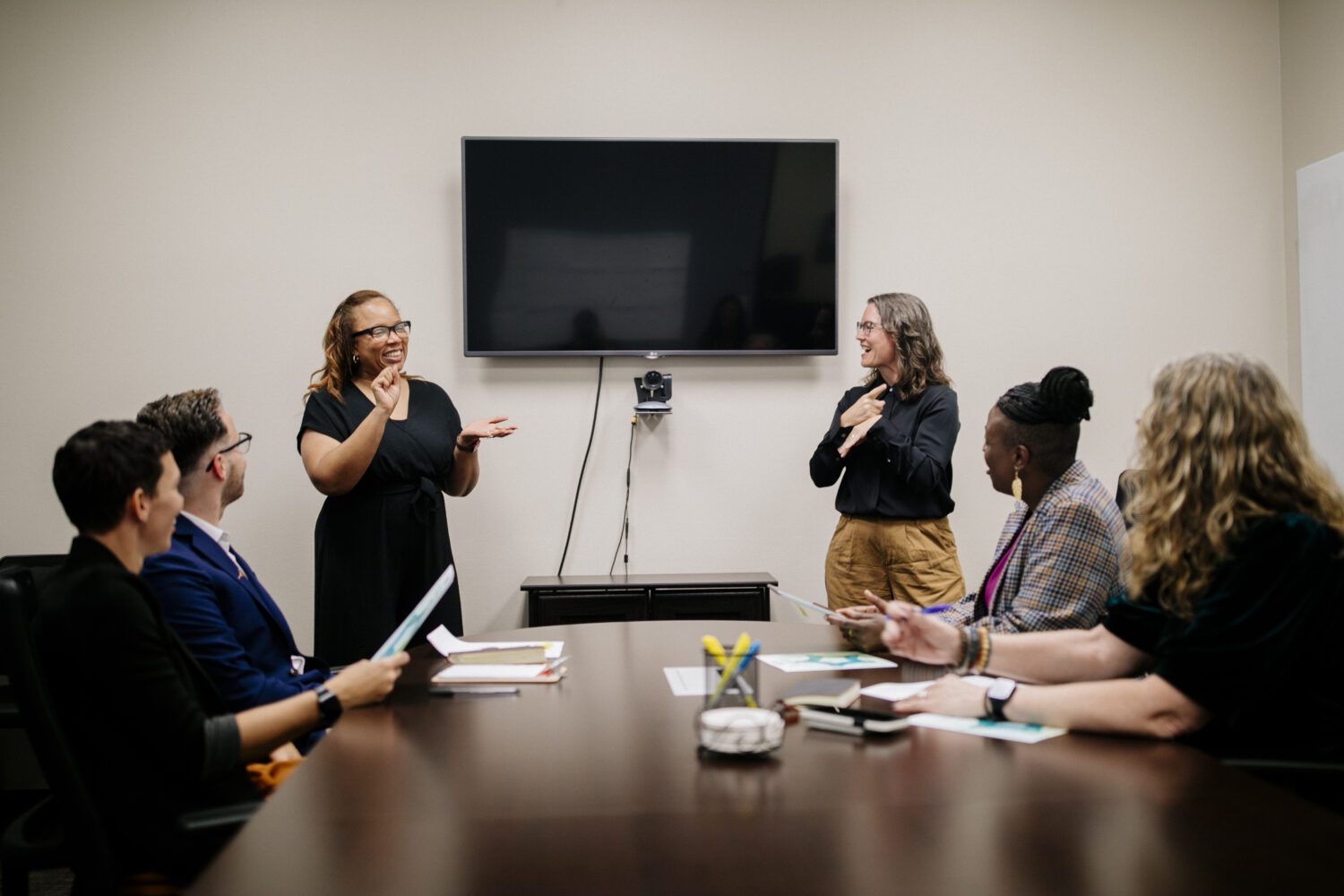[video:https://youtu.be/nfKrPmkQAOM]
Colleges and universities across the country have seen historic shifts in the way they serve students with disabilities in online learning environments during the pandemic. However, in a recent panel discussion, deaf college students said that accessibility barriers continue to be a major hurdle and often go unresolved.
As the country begins reopening to greater capacities, institutions must start proactive planning to ensure access for deaf students while maintaining safety practices and guidance.
To help support that planning, the National Deaf Center (NDC) recently held the panel Supporting Deaf College Students: Perspectives from Disability Services on Campus Reopening, which featured experienced disability services professionals who shared strategies for addressing various challenges in anticipation of reopening campus.
These panelists shared first-hand accounts about how to be creative and flexible in your strategies for access — whether in-person, online, hybrid, or other type of learning environment.
The panelists were:
- Jason Altmann, Harper College – Director of Access and Disability Services
- Kate Skarda-Lewandowski, University of Wisconsin-Madison – Access Consultant, Deaf and Hard of Hearing at McBurney Disability Resource Center
- Alicia Guevara, Lone Star College – Director of Accessibility Services & Resources
- Myrna Marinik, St. Mary’s University – Associate Director of Student Accessibility Services
Strains on the Provider System
As deaf students moved online, the need for different types of accommodations increased, as did the need to train faculty and providers on the new normal of virtual learning. Availability of service providers, access to equipment and technology, and working with new platforms added new hurdles for disability services professionals.
“When thinking about COVID, initially, our biggest challenge was making sure everyone had the technology and equipment they needed to provide remote service from home,” Alicia said. “We had to determine if our providers, like interpreting or captioning providers, had appropriate internet services, as well as equipment, backdrops, or whatever else they needed at home to be able to provide those services effectively for students in their online classes.”
The surge in requests during online learning also put pressure on the provider system itself, leaving it overwhelmed at times.
“We did not have enough service providers,” Kate explained. “The need for them increased for us, so we had to depend more on our local agencies, and even they were spent. We had to hire more hourly interpreters to make sure we can commit to providing full access.”
Myrna had a different experience at St. Mary’s when it came to online access.
“Our biggest challenge prior to COVID was being able to get good quality audio to our CART providers to type or caption for our students. Some people talked about the difficulty of getting good quality audio when you have a large classroom,” Myrna said.
“But when we went online, the audio was beautiful because the captioner could log into the Zoom and hear everything clearly as well as easily identify who was speaking. Students were very excited about doing everything online. Our students, who rely on CART very much, enjoyed being home and able to access their class through Zoom.”
Teaching Faculty About Accessibility Online and Beyond
Whether classes are online or in-person, it’s not just students and providers who need support and assistance. Faculty often need help not only understanding the new technology, but also making it accessible to deaf students.
“Online courses and face-to-face courses are two different ballparks,” Jason said. “Faculty were amazed at how much more work they had to do to make online classes accessible compared to in-person classes. Everything had to be accessible to those students, no matter what faculty decided to put in that class, so deaf students could have an equivalent experience.”
The faculty at Kate’s school not only learned about technology, but also about the time involved to provide quality accommodations.
“Our professors learned that closed captioning requires more time and that we needed to have this media a week or two ahead of time. So COVID helped educate some of them on the process, making things more accessible.
“During COVID, we had to find ways to make processes easier and learn to be creative. Now it’s a matter of incorporating those lessons back into in-person classrooms,” Kate explained. “Once we figure that out, things will be even smoother than before.”
In the virtual classroom, times can be a bit more flexible, sometimes going long or calling last-minute sessions. These changes created new challenges for Alicia’s team.
“One of the problems was professors going rogue on their class times. For an in-person class, the next class must come in at a set time to use the space, so you must finish your lesson on time. But in the remote setting, a lot of the professors would decide to extend their class for thirty minutes or longer. Our interpreters and transcriptionists needed to get to their next assignment, but this class was still going on. It was frustrating for the providers in those situations. Hopefully, as we move back to more regimented in-person classes, the situation will resolve itself.”
The Impact on Deaf Enrollment and Accommodation Participation
The move to online learning impacted the enrollment and accommodation requests of many institutions in different ways. Our panel noticed trends in their institutions, both positive and negative.
“A lot of our students that are deaf and hard of hearing don’t necessarily have the heavy English reading skills required for a lot of the online course content. In a face-to-face program, the teacher is explaining everything in the classroom. Online, you just read through it on your own and are expected to understand it,” Alicia explained.
“Because of that, our deaf student enrollment decreased by 90%. During that first semester that COVID hit, a lot of deaf students tried to finish out the semester, but many of them did not successfully finish. And they have not enrolled since. We started doing a bunch of outreach to them, saying that we have all those face-to-face classes back, and we hope they are interested in returning.”
Myrna found the opposite reaction at her school.
“We found that a number of hard of hearing and late-deafened students who have been enrolled in this school for a number of years really enjoyed the capacity to have closed captions on Zoom. Many of them had never asked for accommodations and were not even aware of CART,” she said. “But once we started talking about services and their options, they were like, ‘Wow, I really wish I would have known this existed before. I’ve been struggling all of these years.’ I’ve had more students come out and ask for services since COVID started.”
Kate found a similar trend at her school as more students began to self-identify during the pandemic.
“We saw a number of students identify as deaf, hard of hearing, or have some kind of hearing loss. Because of social distancing, masking, and using remote learning, many more students self-identified because they realized they were not getting equitable communication access due to the additional barriers. Now for the fall as we go back to campus, we’re seeing even more students self-identifying and saying that they have hearing loss and wanted to know what accommodations are available. That’s good for us.”
Advice for Working with Deaf Students
With classes shifting from online to in-person or hybrid and policies like masking changing constantly, it can be hard for disability services professionals to find creative and flexible accommodations for their deaf students. All our panelists agreed that no matter what the challenge, one thing is always true: listen to the student.
“I always ask what has worked and not worked for you? What have you tried before, and tell me about your experience with it?” Myrna said. “It might be an intervention or accommodation I never thought of. It’s about student choice: what do they prefer, and how do they learn better? Having that interactive meeting with them and really brainstorming together, not just prescribing accommodations to fit a specific diagnosis, can really help.”
“And don’t be afraid to ask for help,” she added. “Colleagues from the National Deaf Center have been so, so helpful. There’s no reason we need to reinvent the wheel. Chances are, we’re all struggling or had the same struggle in the past. Learning from each other is extremely beneficial.”
Alicia had similar advice. “An audiogram or letter from an audiologist can’t really tell you what a person is actually experiencing. Asking questions, like ‘how would you access information when you’re speaking to someone?’, ‘do they rely on their mouth and facial expressions or the information on the board?’ can give you clues. And it’s okay to try things, and they don’t work. Just keep collaborating”
“Many students I work with are new to accommodations, in general,” Kate added. “They don’t know what’s available. They don’t know what will work best for them, what they need, or what’s out there. They might not have had an opportunity to use CART or assistive devices. Sometimes we must expose them to access opportunities. That’s very important.”
Jason also advised attendees to always have a student-centric attitude.
“I can’t emphasize enough that students are our consumers. They’re attending schools to receive an education. It’s our job to ensure an equitable, inclusive learning environment for them. Any concerns they may express to us means there’s a reason behind that concern. If they say they don’t like a particular interpreter, there’s a reason. It’s important to listen to the student’s needs.”
As all the panelists agreed, use your networks. Reach out to your colleagues and to NDC. We’re always available to help you face any type of question that may come up.
Join NDC’s listserv to stay up to date on the latest news and information and connect with us on social media.
For additional strategies, watch Deaf Student Access: Tips & Resources for Reopening Campus or contact the NDC | help team.








